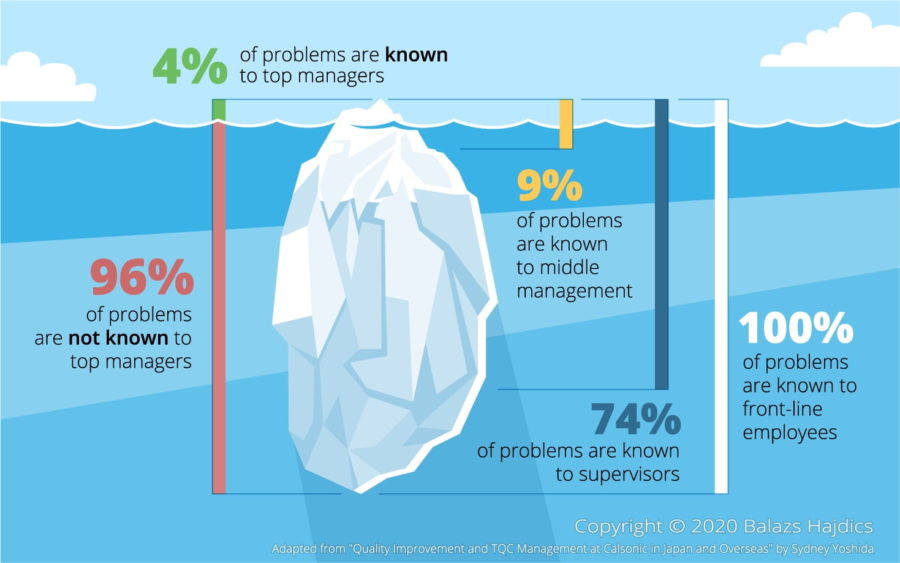Introduction
The list of things that can threaten an organization’s success is long: inappropriate tools, technological issues, project management frameworks that are not fit for purpose or are not followed, failure to respond to customer needs and market changes or a business culture that does not fit the purpose of the business.
Some of these threats are so fundamental that they are connected to and influence all aspects of an organization. These may directly or indirectly influence what tools the organization will select, how and who will it hire and promote, what structures it will create, what business processes it will develop, which markets it will enter, the quality of its products, and so on and so forth.
In this article I’ve selected the top 5 of these omnipresent threats. For each I’ll explain the phenomenon, why it’s happening, what the associated costs/consequences are and what can you do about them.
Unlike my other articles, this one is not written in a self-coaching format.
Be prepared, some of the topics are counter-intuitive or may contradict public thinking. Nevertheless there is a growing evidence base supporting these statements which also coincides with my personal experience. I hope you’ll find them valuable.
1. A culture of deception and lying

“Deception refers to acts by which a person misrepresents information to communicate a false sense of reality to others. Deceptive behaviors range from outright lying to strategically omitting or altering details of information shared with others. Such behaviors are extremely common, with numerous studies revealing the average person uses some form of deception in one out of every five social interactions.”
Erin M. Bryant – Professor, Arizona State University & Patricia M. Sias – Professor, Washington State University
What is the cost of deception?
Lots of practical and psychological things are necessary to reach high performance in organizations but all of them are built on trust and Psychological Safety. Resolving any dysfunction in teams requires restoring trust first.
Trust is hard to build and is fragile: even the smallest amount of lying, pretending or deception can erode it quickly. Psychological Safety is a form of trust; it’s also vulnerable to deception.
A company culture which condones, normalizes or encourages deception leads to:
- the breakdown of effective teamwork,
- strained and dysfunctional working relationships,
- reduced capability to adapt to changing customer, market or technological needs and challenges,
- low employee well-being, motivation, performance and retention.
Why do we lie so much at the workplace and what can you do about it?
We lie for two reasons: 1) there is a practical incentive for lying or 2) there is a psychological incentive for lying.
Practical incentives
Examples of practical incentives are personal gains (bonus, promotion), competition and covering up mistakes.
I’ve seen numerous instances when someone took credit and received praise for someone else’s work, badmouthed an excellent colleague to get the promotion instead of him, or simply lied about hard figures to get a bonus.
Removing practical incentives for lying involves replacing competition with collaboration, tolerating certain types of failure and removing financial bonus schemes.
How we deal with competition and failure has a significant impact on our company’s performance and our employees’ well-being so I’ll revisit these in detail later in this article, keep reading.
Psychological “incentives”
We all tell ourselves stories about ourselves, about who we think we are. E.g. “I am smart.”, “I am special.”, “I am socially weird.”, “I am successful.”, “I am a loser.”, “I am a friend.”
We call these self-stories.
Self-stories make us rigid: we struggle to do, experience, think or feel things that contradict them.
The latest psychological research shows that the more attached we are to our self-stories, the more prone we will be to lying. We will lie to protect our self-stories, our ego, even when there is absolutely nothing practical to gain by lying.
We can learn to loosen up our attachment to our self-stories, using evidence-backed techniques from the latest psychological research. We can learn to open up in front of colleagues, be able to be vulnerable, stop lying and build trust. Check out point 3 in my previous article to learn some techniques you can use to loosen up your attachment to your self-stories. Alternatively, get in touch, I’m happy to help.
2. Internal competition

To understand when internal competition can help and when it can hurt your business we first need to look at the concepts and functions of competition and collaboration more closely.
Competition: benefits and disadvantages
Competition is when two or more people or groups fight over limited resources. A limited resource can be anything: a promotion, a bonus, funding for a project, an award, etc. Not all participants can attain the resource, frequently only one participant is rewarded. Competition, in practice, involves getting ahead of other people or groups, either by working harder or smarter or by sabotaging them.
Competition produces redundant output (products, services). Sometimes this redundant output can be consumed, e.g. two products serving the same need are available on the market and some customers buy the first while others buy the second. In the case of internal competition, most of the times the redundant output cannot be consumed and it’s wasted, e.g. two departments developing their product ideas into detailed project plans but only one gets the funding.
A competition might be friendly or vicious but competitors can never be true friends as the only way that one can win is if the other loses. Competitors are adversaries. Competition quickly degrades trust between employees.
Competition undoubtedly leads to better individual performance in most cases as participants force each other to perform better knowing that only the winner can take the price. The fundamental assumption behind competition is that this individual performance gain translates into performance gain at the organizational level as well. As we will see, this is rarely the case in knowledge work.
Collaboration: benefits and disadvantages
Collaboration is when two or more people or groups can only attain an outcome or complete a task if they work together because the contribution and expertise of all of them is required. They have an interdepency around a task or an outcome. Collaboration in practice involves interactively exchanging help and resources to achieve a shared goal or outcome. The closer the collaboration required to complete a task, the more bonding is required between participants. Some types of collaboration also require that participants deepen some of their interpersonal skills, like conflict resolution or making decisions in groups. This can take a lot of time, money and effort. Collaboration is hard.
Collaboration is the opposite of competition.
Collaboration between people creates a team, the output of a team is more than the sum of the output of its members (the teams functions as a System). Members can improve the team’s productivity and the predictability of deadlines and budgets by load-balancing (helping each other out when one is stuck or overloaded). They can design better products by feeding off of each other’s ideas and taking advantage of the diversity of thinking they have. They can also reduce overhead costs by coordinating and working together closely, without a middle-man.
When should we encourage competition between employees and when is encouraging collaboration better to maximise performance?”
As competition and collaboration are by definition the opposite of each other, in any moment we can only do one of the two, so we have to make a choice.
Competition leads to higher performance when:
- A single individual can produce results alone. E.g. sales people frequently can sell a product to a customer without help from other sales people.
- If the competition is between teams, then any team can produce end results for the customer on its own, without ever interacting with the teams they are in competition with.
- The redundant output produced by competition can either be consumed or its associated cost is insignificant.
- Competing individuals will not have to form a team in the future. As competition degrades trust and trust is the foundation for any form of team-work, it will be very difficult to work together effectively on the same team after having competed fiercely for years.
Collaboration leads to higher performance when:
- Contribution from multiple people, maybe even multiple disciplines, is necessary to deliver end results to the customer. Most forms of knowledge work typically fall into this category. E.g. software development, research, biotech, etc.
- The level of contribution required from each person varies greatly between tasks. Collaboration enables balancing out these which leading to improved productivity and predictability.
- The work at hand requires innovation. Innovation means finding new solutions to existing problems. The process of finding new solutions involves trying out lots of completely new ideas, most of which will inevitably fail.
If individuals are afraid that they will lose in a competition because of temporary failures, they will avoid trying out new things. Collaboration contributes to a safe environment where innovation is possible. Furthermore, innovation usually requires multiple people brainstorming and working together. - The work has a significant creative element to it, e.g. software development, marketing, etc. All creative people know that the creativity of a team which bounces ideas off of each other is greater than the sum of the creativity of its members.
What are the psychological and practical costs of internal competition?
- Severely reduced employee well-being.
Your work is not valuable in itself. You might be in the top 1% of experts in your profession but it doesn’t matter: if one of your colleagues is just a tiny bit better, you will lose and your efforts are wasted. This creates constant uncertainty, anxiety and fear. It also provokes anger as working for nothing is not fair.
- Increased stress levels and waste.
You probably heard of the Pareto principle: “for many outcomes roughly 80% of consequences come from 20% of the causes”. Or the law of diminishing returns: “The law of diminishing returns is an economic concept that shows that there is a point where an increased level of inputs does not equal to an equal increase [sic] level of outputs.” Or in other words you keep working hard on the same thing but your results don’t increase substantially.
It’s economical, safe and wise to stop at that point but competition doesn’t allow you to do that. You have to double or triple your efforts even if your results will only get 1% better by doing that, otherwise you will lose and get nothing.
This unnecessary and uneconomic pressure significantly increases stress levels in employees and wastes company resources.
- High staff burn-out rate and turnover. Increased costs due to backfill and handover.
Handover time, hiring and training new employees is one of the biggest overhead expenses in knowledge work. Nevertheless companies don’t measure this cost, so most of the time it’s completely ignored.
- Reduced learning. Difficulty aligning employees with product / company Visions, Missions or Values.
Competition means you have no friends, you cannot ask for genuine help or support from anyone. People will feel increasingly lonely and isolated. Without a feeling of belonging, and trust that support and care will be received if needed, people do not view themselves as part of the organization even if they say otherwise. People who don’t feel they belong will be much less inclined to align with company policies, norms, Values, Missions, etc.
- A culture of deception.
Inevitably those who are willing to deceive others will have a higher change of winning, being seen as successful and being promoted. Over time more and more people will be selected who engage in deception. Soon this will undermine all aspects of the organization.
- Inability to collaborate when collaboration is necessary, which leads to loss of business and profit.
As mentioned before, competition undermines the trust necessary for collaboration. Furthermore, if somebody practices doing something a lot, it becomes very difficult to do the opposite of that. That’s natural, it’s part of how humans learn and build patterns of behaviour.
We see this frequently in digitalization and digital transformation projects, when non-software companies with competitive cultures create new departments to develop software in-house and then really struggle to produce absolutely minimal results for 10x or even 100x the market costs. The culture of collaboration they would need to implement is fundamentally incompatible with the culture of competition they have.
- If competition is encouraged when there is task or outcome interdependence, then quality issues, delays, budget overruns, useless product features and dissatisfied customers are almost guaranteed.
3. Low or no tolerance for failure

Thou Shalt Not Fail
Most organizations discourage and punish failure in various ways. The range of techniques is wide: blaming, publicly humiliating employees, putting them on “performance improvement programmes”, withdrawing financial bonuses or project funding, demoting or if all else fails firing. We could probably fill a book if we wanted to gather and elaborate all the methods and abuses used to make it clear: failure is unacceptable. But do these practices work on the long run? What are their costs? What are their benefits?
Why do we punish failure?
Fear–based management is based on four fundamental assumptions, all of which have proven to be incorrect:
- Most failures are deliberate. Numerous research and experts like Amy Edmondson highlight that in most organizations usually a very small number of failures are deliberate (1-5%).
The majority of the mistakes have causes which are not resolved by punishing the individual who made the mistake. Some examples:- process problems (e.g. key information is not shared on time as a process dictates it otherwise),
- cultural problems (e.g. competitive behaviours take the place of collaborative ones and they hinder achieving shared goals),
- missing skills (e.g. there was no budget to upskill),
- insufficient time allocated for quality control,
- etc.
- Fear of punishment motivates people to perform better.
Fear is the single best motivator to persuade people to avoid doing something, but it’s the worst possible motivator to inspire people to do something better. As such, fear of punishment is only good for preventing deliberate wrongdoings like stealing company money; it’s not good for making people perform better or become better at what they do. Furthermore, as we will see later, fear comes with an incredible cost as it erodes Psychological Safety which makes its application pragmatic only in an extremely small number of situations. - Failure can be prevented in most cases.
One of the key characteristic of problems we solve in our everyday work-life is what we call problem complexity. As I wrote about it earlier, failure is an inherent and unavoidable part of solving problems of a certain complexity. These are so called Complex or Complex Adaptive problems and as it happens, the 21st century provided a proliferation of these problems while it decreased the relative abundance of other types of problems. Failure is not avoidable anymore, it’s an intrinsic part of solving problems. - Avoiding failure means you will get the product or service you want.
Focusing on eliminating what you don’t want doesn’t mean that you will get what you do want. The best example is when you turn on the TV, you don’t like the show you are seeing so you quickly switch to another channel (metaphorically you “fire and hire” a new channel). Whilst you have eliminated the “defect” chances are you did not end up with the show you truly desired. Focusing on what we do want and rewarding moving toward that is more important than focusing on what we don’t want and punishing it.
What are the costs of having low or no tolerance for failure?
- It creates an unsafe environment where speaking the truth is dangerous. This in turn slowly builds a culture of deception where adjustments put in place are based on a false reality and key information necessary for decision making is not made available on time. Read Dr. Amy Edmondson’s (Harvard University) paper about Psychological Safety.
- As a direct consequence of the point above “the yes-men” (people who always say what you want to hear) have a higher chance of surviving and becoming promoted. This erodes the organization’s capability to adapt to changing market conditions or customer needs as that would require making the truth visible.
- Reduces employee development and well-being, as that requires a Psychologically Safe environment.
- Generates fear and anxiety which impedes collaboration (people won’t help each other that much, they won’t work toward a common goal).
- Eliminates or reduces innovation, as innovation is not possible without (a lot of) failure. There is a maxim “Anyone who has never made a mistake has never tried anything new” (which is often attributed to Einstein). Without innovation the company’s days are counted.
How can I change?
Low tolerance for failure is a good thing if the consequences of failure are devastating and cannot be repaired (e.g. loss of life). Although there are industries (e.g. pharmaceutical companies) which deal with problems like that, most of us solve problems where failure is not devastating.
Some tips of what you can do starting today:
- Stop punishing failure, unless it’s deliberate.
- Decrease hierarchy and power dependence to create safer and more productive environments.
- Create a Psychologically Safe environment by:
- Rewarding people who speak up in everyday interactions, especially if you don’t like what they say.
- Using professional Facilitation and evidence-based Coaching.
- Creating forums where past threats and abuses can be shared, discussed and resolved safely. (This also requires a Coach or Facilitator.)
- If you are solving Complex problems (e.g. you develop software), then implement policies which reward failure if there is a learning for the individual, team or organization. Work towards making failure as cheap and fast as possible as it’s unavoidable.
- Use evidence-based Coaching to help employees and managers learn from their failures and embed lasting behaviour changes into their work-lives.
- Reward teams, instead of individuals if collaboration is necessary for value delivery.
None of the above means that we should be naive. If a failure is a consequence of an individual’s mistake and that individual keeps repeating the same mistake over and over again and does not respond to training or coaching, then you must protect your team or organization from his deliberate ignorance and negligence.
4. The selection criteria for Managers and Leaders

Hiring, promoting or growing bad managers and leaders can have a devastating impact on a team’s, department’s or company’s products, customer satisfaction, bottom line or employee well-being.
Whilst there is a plethora of leadership skills one has to learn to become a good leader (I provide training in these, if you are interested, contact me), none of these skills matter if the aspirant leader has the wrong motivation for becoming a leader. It’s not obvious why this is the case, so please bear with me, I’ll explain.
Internal Motivation vs. External Motivation
We only seek to engage in activities that help us fulfil one or more of our needs. We all have basic needs that can be fulfilled by money, e.g. food, water, clothes, etc. We also have more sophisticated needs like the need to learn and evolve, belong to a community or to do something meaningful with our time that has an impact.
The people who are the best in what they do are the best because the activities of their everyday job are directly connected to and fulfil one of their internal needs.
E.g. you will find that the best researchers in the world are naturally very curious people, they fulfil one of their strongest needs (to learn more) by doing their jobs. This internal drive is way more powerful than any external motivators (like money or punishment) can ever be so people who have this drive inevitably become better researchers than those who don’t.
So what internal needs can be fulfilled by doing the every-day job of a leader?
One of the human needs is a need for status and recognition. This need is usually fulfilled through acquiring a) praise and appreciation from others; b) prestige, privilege and money; c) symbolic things like ranks and job titles.
The need for status and recognition is a self-serving need. “I want to feel special.” “I want to decide which product feature to develop.” “I want to decide who is fired, promoted and hired.” There is nothing wrong with self-serving needs in general, without them we wouldn’t have survived as a species. (E.g. think about feeding, the need I feel is for me to eat, not for somebody else to eat and without feeling this need I wouldn’t have survived.)
However, it’s not possible to lead anything or anybody effectively and efficiently when one’s motivation is self-serving. Why?
Leaders don’t create or develop a company’s products and services themselves. They don’t code, fix bugs, design marketing campaigns, sell to the customer, etc. (I know there are leaders who part time lead and part time do activities of their original profession but the leadership element is not about doing the work hands-on, rather it’s about helping others do the work.)
Leaders do a lot of things though: they enable, empower, teach or train, mentor, coach, guide and oversee others while they are creating and developing products and services. Leaders help others realize their full potential, perform better, achieve their targets, learn and evolve. Leaders also help the company achieve its goals and targets.
What internal need is fulfilled directly by the activities above?
The need to serve. Leadership is a service role. You help others achieve, you help your company achieve.
Service is the opposite of self-service, so by selecting, promoting and hiring people who want status and power into manager and leadership positions, you essentially select the diametrical opposite of what would work best.
There may be processes and policies trying to force me to make choices that benefit my company and team more than they do benefit me. There may even be financial incentives to do the same. However, none of these will work on the long term if my internal motivation is to serve myself (a need for status and recognition). Countless research has shown that external motivators (like money and punishment) are less strong than internal motivators (like the need for status and recognition).
What is the cost of selecting, promoting or hiring people into managerial positions who are motivated mostly by achieving status and recognition?
Managers with self-serving motivations will be more inclined to put their own interests over the interest of the company and its employees if the two happen to come into conflict, they may:
- Suffer from cronyism: they may promote and hire employees based on their personal preferences instead of company interest.
As professional or collaborative skills matter less in employee selection, the company inevitably underperforms.
- Withhold information from or lie to their superiors, direct reports or other departments to defend their position and status.
This will inevitably lead to plans and adjustments made by the company failing, as they are built on a false, misrepresented reality. The consequences are dire: decreased customer satisfaction, loss of profit, loss of business, reduced employee well-being and retention.
- Build unnecessary layers of hierarchy or an army of managers reporting to them.
If your manager to doer ratio is greater than 10% in any department or team, be suspicious. People who crave status and recognition will often measure their value based on how many managers report to them and they will artificially inflate this number. This costs money for the company and as extensive hierarchies are slow, rigid and irresponsive to changing customer and market needs, the company may also lose market share and customers.
- Make decisions as a way of asserting their status even when they don’t have the expertise or detailed enough information to make good decisions.
Although a culture of fear may prevent employees from talking about this phenomenon, it doesn’t prevent them from seeing through it. Employees lose trust and respect toward their Manager which in turn requires the Manager to resort to even more draconian measures to make and execute decisions. Instead of expertise and access to detailed and pertinent information, status dictates more and more who can make decisions. This inevitably leads to an increasing number of incorrect decisions which negatively affects all parts and aspects of the company.
- Managers at the absolute end of the self-serving spectrum often make it to the news: we often see that, for private gain, some are willing to go as far breaking the law (e.g. handling the money of terrorists and drug lords), causing significant environmental damage, opposing or ignoring safety regulations and leaving employees crippled. The company may face significant fines, lawsuits or prosecution as a consequence.
What should I do if I am primarily motivated by achieving status?
There are two paths you could take.
First, there are a number of exercises you could practice to become more open and connected to others, tuned to their needs and feel more equal to them which are the first steps in becoming a better Leader. Check my article about Psychological Flexibility, (especially point 3). This only scratches the surface though, so get in touch or read some of the books recommended in that article to learn more.
Second, if all else fails, there is a list of professions where being motivated by status doesn’t hurt anybody or it may even help you do that profession better than others. Two examples that immediately come to my mind are actors and athletes. Consider changing profession and taking career coaching, it’s never too late.
How can we attract people with the right motivation to Leadership and Management positions?
The counter-intuitive but extremely important takeaway is that we have to decrease the level of status and recognition of managerial and leadership positions in order to attract and grow better leaders.
This requires both practical changes (e.g. employee appraisals performed by committees of experts instead of the line manager) and changes in our social interactions (e.g. employees are not to treat managers as if they were special in any way).
How to do this in practice is different for each organization and depends on the context and details (this is part of what I do for a living). However, I’d like to give you a few tips.
A few tips to attract and grow people who have the right motivation to become a Leader
- Evolve into a better Leader by loosening your attachment to your ego-characters using exercises from the latest psychological research.
Check out point 3 in my previous article about Psychological Flexibility which contains exercises you can practice regularly to help you evolve into a better leader.
- Make Manager and Leadership positions less attractive to people who want status and power.
- Reduce prestige and privilege associated with Manager positions. E.g. you could:
- Make Managers sit with “normal” employees, in the same space.
- Regularly organize lunches and/or dinners where Managers sit and eat together with employees.
- Appoint two people for the same position with shared power.
- Delegate decision making authority to lower levels of your organization if possible.
As I wrote about earlier, some problems with certain complexities may even require the delegation of decision making power to make the organization more effective and efficient. - Create committees who make sensitive decisions by voting.
People wanting status want to be the ones who make sensitive decisions so these become a playground for power games. E.g. pay rises; assessment of employees; decisions about which project/product to finance, etc.
Some tech companies assess employee performance with committees which comprise of peers, very senior developers (experts) and junior developers (how much have you helped them) but the committee doesn’t contain the assessed employee’s line manager, he has no vote (although he provides a recommendation, that can be ignored). - Incorporate employee retention into the assessment of Managers and if employee attrition reaches a certain point (e.g. 30% annual), then replace Managers automatically.
- Decrease the pay difference between Managers and employees.
- Make your organization more flat, i.e. decrease the hierarchy. If there are less levels, then higher levels have less status and prestige.
- Remove words from the job title that convey status. E.g. Chief, Head of, etc.
- Reduce prestige and privilege associated with Manager positions. E.g. you could:
- Make Manager and Leadership positions more attractive to people who want to serve, have a vision and believe in something.
- Look for people who have a strong Vision for a product or service. Vision means there is proof that they have been pursuing their idea even when there were no rewards or punishments in place, it’s intrinsically important for them. If their Vision for a product fits into the portfolio of your company, they might make good Product Managers.
- Introduce metrics into the assessment of Managers that measure how much they helped or enabled others to deliver, learn and evolve. Regularly ask employees about this in anonymous questionnaires.
- Reward Managers based on value delivered to the customer (find a way to measure this).
- When hiring or promoting Managers, don’t assess leadership skills and motivation based on verbal discussions as it’s easy for one to “sell” themselves. Use assessment centre style interviews instead. These are carefully designed situations which simulate a real-life scenario and the candidate has to interact with multiple people and work toward solving a problem together. You will see how the candidate coordinates, organizes, coaches, leads, etc. in practice.
5. Hierarchical attitude toward others

It’s important to make a difference between formal hierarchies and hierarchical attitudes held by people.
Formal hierarchies can be either useful or harmful depending on how they are implemented and what the complexity of the problem to be solved by the organization is. On the other hand, hierarchical attitudes almost always grow to a point where they are harmful.
A hierarchical attitude toward other people is when we organize them into successive ranks or grades with each level subordinate to the one above.
This organization may only exist in our heads, it may be different from how people are actually organized, also it may contain arbitrary considerations (e.g. determining rank based on accent).
- A hierarchical attitude can lead to determining the value and importance of others and the desired behaviour toward them based on where they sit in our internal, imagined hierarchy.
- It’s possible to get to the point where position, status and rank become the primary factor in decision making.
- Hierarchical attitudes can grow to the point that we put ourselves above others, with a feeling of entitlement. Many people who suffer from this frequently think that they are “better” or “more valuable” than others or they deserve more. Alternatively they may suffer from low self-esteem (both phenomena being the consequence of the same attitude).
- If left unchecked, the tendency to create a hierarchy of people by categorizing and evaluating them can quickly reach a degree where it has a life of its own and becomes very harmful for organizations and people alike.
- Hierarchical attitudes make us more likely to engage in competitive behaviour, be motivated by status (as our value depends on it) and become bad leaders.
- At its extreme, one may put oneself above the truth which leads to excessive lying. Furthermore, as discussed earlier a strong attachment to self-stories also increases the occurrence of lying.
In essence a hierarchical attitude is the underlying problem behind many of the issues discussed in this article.
Why do we do this?
Categorizing and evaluating human beings the way we would categorize objects or events is a capability that is built into human cognition. Doing this in an automatic way, sometimes without even realizing it is also a property of cognition, consequently from time to time we all engage in this activity.
There is a psychological skill that enables us to reduce the automatic nature of this capability and take back the control over what we do with these internal categories and hierarchies. Numerous things contribute to the development of this skill which, in part, is the reason why some people are more hierarchical than others.
What is the cost of hierarchical attitudes at the workplace and what can we do about it?
- Whilst the hierarchical attitude of managers may temporarily increase productivity, it severely reduces performance, restricts employee potential and damages employee well-being in the long-term.
I recommend reading this self-coaching article about where the strongest motivation comes from.
It’s risky to provide a short summary as without doing the exercises in the article one may not connect with the key takeaway but I’ll try nevertheless:
Ownership and motivation are not dependent on the difficulty or painfulness of a task, they’re dependent on how much freedom one has in choosing and doing that activity. If I choose to do something, I do it for myself, if I’m told to do something I do it for you. Inevitably my motivation is higher when I do something for myself.
Hierarchical relationships involve telling people what to do, which deprives them of free choice, decreases their level of ownership and motivation which in turn leads to reduced performance and employee well-being.
A proven alternative is to define desired outcomes and use coaching to help people achieve those outcomes in ways they choose. Coaching is an egalitarian relationship as the Coach does not put himself/herself above the coachee and does not instruct him/her.
- Prevalent hierarchical attitude renders people higher in the hierarchy lonely and socially isolated. It fills their lives with fear, anxiety and anger as they have to constantly fight to protect their position and deal with adversity, betrayal and back-stabbing.
It’s not possible to connect to someone, create strong bonds as colleagues or friends from a position where I think I’m better than him/her. That judgement separates us. Why would I mix with somebody if (s)he is below me? Why would I even listen to an employee’s idea when I’m superior in all regards?
As people higher in the hierarchy become more and more isolated from people lower in the hierarchy, collaboration becomes difficult and key information won’t reach decision makers anymore, they start to talk only to people who are also high in the hierarchy. They start to live in an alternative reality, a bubble. This slowly undermines all aspects of an organization and leads to loss of profit, customers and talent.

The negative social impacts of hierarchical attitudes are frequently amplified by the practicalities of them, e.g. if someone is viewed as special in a group, then many people will work, fight, lie or back-stab to get his/her position. This constant threat leads to fear, anxiety and mistrust. A lack of safety leads to the implementation of excessive and unnecessary controls and deepens social isolation and loneliness in all parts of the organization which then further erodes collaboration.
It’s possible to learn techniques and exercises that help us loosen our attachment to our self-stories. E.g. I’d recommend the book “The Happiness Trap”.
- Hierarchical attitudes frequently lead to lower quality decisions because decision making authority is more likely to be assigned to people who are high in the hierarchy instead of people who have the most current, pertinent and detailed information available to make a certain type of decision.
Read the next point for the alternative.
- Hierarchical attitudes cry out for centralized decision making which only works well for a narrow range of problem complexities.
The ideal level of hierarchy from the perspective of decision making depends on the complexity of the problem the organization is trying to solve. Check out this article about selecting the ideal organizational design.
In today’s increasingly complex world most organizations are dealing with problems that require decision making to be decentralized or distributed, decisions to be made at the closest point to the work as there is so much information arriving at such a high frequency that central decision making is both ineffective and inefficient. People with hierarchical attitudes have an inclination to choose a centralized decision making structure even when it doesn’t work.
- Hierarchical attitudes reduce business agility, adaptation to changing market conditions and innovation because they introduce behavioural rigidity.
As mentioned earlier we all tell ourselves stories about ourselves (e.g. “I am smart” “I am successful.” “I am a loser.”) This is part of normal psychological functioning but it has a side-effect. Self-stories make us rigid: we struggle to do, experience, think or feel things that contradict them. E.g. If I’m smart and I struggle with a complicated task it can feel almost like dying.
Hierarchical attitudes are the consequence of our attachment to those self-stories which tell us that we are better, smarter, deserve more, etc. These self-stories about how great we are will introduce behavioural rigidity in the way any other self-story would. Many people in high-ranking positions in companies struggle tremendously when they need to implement changes in their organization that requires them to change their own behaviour as well. This in turn leads to reduced adaptability to changing market conditions.
E.g. if a lead developer is attached to the self-story that “I am the best developer around”, then he may have difficulty letting go of the micromanagement of other developers, and may perpetuate further mistakes because recognizing, admitting and correcting them would threaten the self-story. When the organization scales, his micromanaging behaviour may become an impediment to the scaling efforts.
The solution is learning new psychological skills that enable us to undermine our attachment to these stories (without trying to change the stories themselves!).
- Most of us spend more time with work than with our families and hobbies. If we work for a hierarchical organization built by hierarchical attitude, then we live in a dictatorship for the majority of our life. Hierarchical organizations steal our freedom.
What percentage of your total waking time do you spend at work? Did you include overtime? What about activities that you wouldn’t do, had you not have to work for your current company (e.g. buying certain clothes or equipment)? What about travel time? Assuming that you cannot utilize travel time for anything else, like reading, this is a time wasted because of work so you should include it.
I found that for me this number was never lower than 50% in my life and most of the time it was between 60-70%. I spent the majority of my life with work.
Do you work for a hierarchical organization? Does any of the following sounds familiar:- Working for this organization feels suffocating and damaging to you.
- You receive lots of instructions, including ones that tell you how to do your job. You must do as you’re told even if the instructions don’t make any sense, even if they are harmful for you or the organization.
- You must minimize the choices you make throughout your day or you must not make choices at all. You must only follow predefined rules and policies.
- Your potential is wasted, your creativity shrivels, you feel in a cage, restricted and restrained.
- You are treated as you are less valuable than people higher in the hierarchy which makes you feel small and worthless.
- Your contributions may not even be measured based on merits but based on your rank which generates anger and anxiety.
- It feels as if there was an almost constant adversity and fear surrounding you.
Do you want to spend the majority of your life in conditions like these?
Neither the shareholders nor the employees of a company benefit from these practices and there are much better alternatives (as we’ve discussed before).
What can we do?
If a publicly traded company engages in practices like the ones mentioned above and you hold shares in it, then do attend the annual shareholder meeting (most of us don’t do this) and vote for replacing the current CEO of the company with someone who makes the organization more effective and humane.
The paradox is that most of us don’t attend shareholder meetings because we only hold the shares to make money but we could make much more money if we attended and replaced the CEO. Our investment would become safer and would have a higher yield.
Claim your free initial consultation and get ahead of the competition today!
I can help you transform your business culture to a more humane and high-performing one.
I use evidence-based Coaching and Facilitation combined with the latest psychological research to help my clients.
info@successfulagiletransformation.com
+44 742 1415 683




Leave a Comment